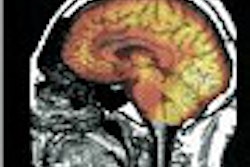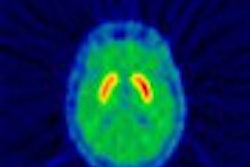A whopping 3,500 positions are currently available for certified nuclear medicine technologists (CNMTs) in the U.S., according to Martha Pickett, chairman of the College of Health Related Professions at the University of Arkansas for Medical Sciences in Little Rock. In 2003, training facilities matriculated approximately 1,200 students, which just about matched the number of CNMTs who were retiring from the profession, she noted.
"We have a graying of the nuclear medicine technologist profession," said Kathleen Murphy in a conversation with AuntMinnie.com at the 2003 Society of Nuclear Medicine annual meeting in New Orleans.
"The average age for practicing CNMTs is in their 40s now, which is part of the reason we think that the shortage is not going to go away anytime soon," added Murphy, who is an associate professor and program coordinator for nuclear medicine technology at Gateway Community College in North Haven, CT.
The aging of CNMTs matches that of the general U.S. population. As more Americans require nuclear medicine services, a decreasing number of qualified professionals will be available to provide those services.
Murphy, who is also chair-elect of the Nuclear Medicine Technology Certification Board, does not believe that current training facilities will be able to make up for the shortfall of technologists in the near future.
"Even though the existing programs are fuller, there are not a lot of new programs opening up, and in fact, some programs are shutting down due to lack of funding. With more and more CNMTs looking toward retirement, I don’t think we’re going to see a cycle of surplus and shortage in the profession again in our lifetimes," she said.
According to the Joint Review Committee on Educational Programs in Nuclear Medicine Technology (JRCNMT), there are approximately 90 accredited programs available in 40 states and Puerto Rico for students interested in becoming a CNMT.
"That’s not a lot of programs, considering the employment opportunities available for CNMTs. In the past, when we’ve seen shortages, we’ve seen a proliferation of new programs opening up," Murphy said.
CNMT requirements
For individuals interested in becoming a CNMT, a high-school diploma or its equivalent is a minimum educational qualification. Murphy emphasized that a person seeking to enter either a two-year associate degree or a four-year baccalaureate program should have a working knowledge of a wide variety of subjects.
"You need to have a good background in math and science, such as physics, chemistry, anatomy, and physiology, strong written and oral communications skills, introductory psychology, and computers," she said.
The curriculum for applying to certify as a CNMT is set by the JRCNMT, and includes methods of patient care, radiation safety and protection, nuclear medicine physics and radiation physics, nuclear instrumentation, statistics, radionuclide chemistry and radiopharmacy, radiation biology, diagnostic nuclear medicine imaging and non-imaging in vivo and in vitro procedures, radionuclide therapy, computer applications, immunology as related to nuclear medicine, as well as quality control and quality assurance.
Clinical requirements for CNMTs are competency-based; thus there are no set number of hours that a candidate must fulfill in order to apply for certification. Although there is no required hour metric, clinical requirements are not insubstantial.
"According to recent traffic on the nuclear medicine technologist program director’s listserv, the mean number of clinical hours that I found students performing is around 800 hours. Some programs have substantially more hours put in by students, but very few have less than 500 or so hours," noted Murphy.
Cost to students for CNMT programs vary from community college-based associate degrees starting at approximately $5,000 for the full two years, to four-year bachelor’s degrees that can run more than $20,000 annually. For CNMT candidates looking for financial assistance, there are scholarships and grants available to qualified candidates.
"There are allied health scholarships available in many areas of the U.S., the Society of Nuclear Medicine has a professional education and development fund for technologists, and the ASRT has an education and research foundation that offers an array of scholarships for entry-level students and professional radiologic technologists," Murphy said.
For radiologic technologists interested in crossing over to nuclear medicine, some CNMT programs offer accelerated learning tracks that can be completed in as little as a year.
"There has not been a great deal of interest from RTs in the past to complete the one-year certificate program in nuclear medicine at our institution," Murphy said. "However, with the increasing use of fusion imaging around the U.S., this may well change."
By Jonathan S. BatchelorAuntMinnie.com staff writer
July 11, 2003
Related Reading
Radiologic science enrollment increases for third straight year, December 4, 2002
Professional group bolsters RT image with education, legislation, November 8, 2002
Radiology extenders -- the answer to the RT personnel shortage?, September 19, 2002
2002 AHRA offers a multidisciplinary approach to radiology management, September 9, 2002
Health policy experts sound alarm over health workforce shortages, September 6, 2002
Copyright © 2003 AuntMinnie.com




















